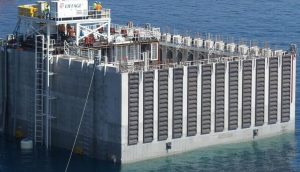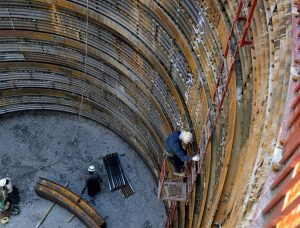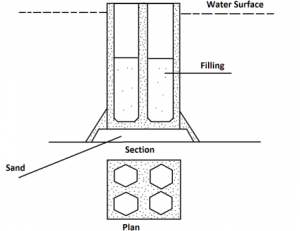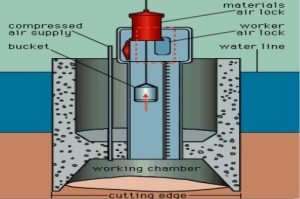Caisson Foundation – Construction, 5 Types and Advantages
Caisson Foundation
A caisson foundation is a watertight retaining structure used as a bridge pier and used to construct a concrete dam and may also be used in the repair of ships.
It is a prefabricated cylinder sunk or hollow box into the ground and filled with concrete and forms foundation to some desired depth.

In the construction of bridge piers and other structures that require foundation beneath rivers and other bodies of water, the caisson foundation is mainly used because caissons can be floated.
By auguring a deep hole into the ground and then filling it with concrete, the caissons are also created, and for a portion of the length of the caisson, steel reinforcement is sometimes utilized.

If a geotechnical engineer finds the soil suitable to carry the building load, then the caissons are drilled either to bedrock or deep into the underlying soil strata. On earth, when caissons rest, they are generally belled at the bottom to spread the load over a wider area and to remove the soil for these belled caissons, special drilling bits are used.
The Need of Caisson Foundation:
For the caisson foundation, there are the following suitable conditions such as;
- When large boulders are contained by soil which can obstruct the pile’s penetration.
- To a large lateral load, When the foundation is subjected, it is used.
- Caisson foundation is used when there is a high depth of the water level in the river and sea.
- In the load compositions, when there are river forces included.
- Caissons are preferred when the load is needed to carry at the end.
- Caisson foundation is suitable when the present groundwater level is aggressive inflow.

Construction Process of Caisson Foundation:
There are the following steps in the construction of caissons as given below;
- Firstly, by a towboat, the cutting edge is floated to the breakwater and buckle to the caisson guide, and into steel forms built up along the perimeter of the box, the concrete is placed into it. The box becomes heavier and sinks into the water along with the caisson guide with every concrete placement.
- Inside the box around the air domes, forms are also built, and in between, concrete is placed.
- The air domes are removed when the caisson finally touches the river bottom, and through the long dredge well tubes, the earth is excavated. Until the caisson sinks to its predetermined depth, excavation continues.
- Concrete is placed into the bottom 30 feet of the hollow dredge wells, and the tops are sealed in the final step.

Types of Caisson Foundation:
There are the following types of this foundation such as;
- Box Caissons
- Excavated Caissons
- Floating caissons
- Open Caissons
- Pneumatic Caissons
Box Caissons:
Box caissons are constructed of heavy timbers and open at the top, and are watertight boxes. To the appropriate location, they are generally floated and sunk into place with a masonry pier.

For the construction of the bridge pier, box caissons are used and are less costly.
Excavated Caissons:
Excavated caissons are placed within an excavated site and are usually cylindrical, and with the concrete, these are backfilled.
Floating caissons:
Floating caissons are prefabricated boxes that have cylindrical cavities and are also known as floating docks.

Open Caissons:
Open caissons are without its top and bottom, and with verticals side only, the open caisson is well, and it may be square, oval, rectangular, or any other shape which is suitable.

This type of caisson is made of RCC and welded together, and in the formation of a pier, these are generally used.
Pneumatic Caissons:
Pneumatic caissons are mainly used for underwater construction and are large watertight boxes or cylinders.
To form a box-like structure, this type of caisson is usually made of inner and outer skin plates with steel trusses to facilitate sinking in the soil. It is provided with a cutting steel edge at its bottom. The working chamber is about 3 to 4 m deep in the caisson, and by providing an airtight roof, it is made airtight.

Advantages of Caisson Foundation:
There are the following advantages of the caisson foundation such as;
- These are economics.
- It minimizes the need for a pile cap.
- These foundations reduce vibrations and slightly less noise.
- To varying site conditions, these are easily adaptable.
- These foundations have high lateral and axial loading capacity.
Disadvantages of Caisson Foundation:
There are the following disadvantages of this foundation such as;
- To construction procedures, these are extremely sensitive.
- For contaminated sites, this type of foundation is not suitable.
- Lack of qualified inspectors and construction expertise.
